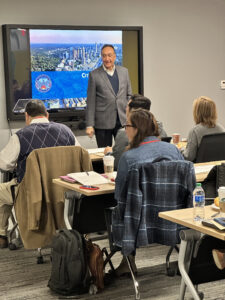Westside Future Fund (WFF) was honored to host former U.S. Department of Housing and Urban Development Secretary and Mayor of San Antonio Henry Cisneros, and a delegation from San Antonio, including ESTAR West, at WFF’s headquarters earlier this year. The delegation included 35 leaders from the Westside of San Antonio, across industries including education, neighborhood groups, city government, economic development, and housing development.
The group came to Atlanta to hear from City of Atlanta officials, transit experts and leaders on affordable housing about best practices for neighborhood revitalization. Cisneros is the chairman of ESTAR, a neighborhood effort in San Antonio described as “the poorest Census tract of the city”. The effort intends to lead with economic development and entrepreneurship initiatives to help spur revitalization within the community.
“I’ve been looking for the best places where we could model ourselves,” said Cisneros. “I read a McKinsey interview [highlighting the work of Westside Future Fund] and it was so powerful in describing precisely the things that we were interested in that I said the best thing we could do is go to Atlanta and see for ourselves.”
The multi-day visit included discussions and a tour of WFF’s service footprint within the historic Westside including English Avenue, Vine City, Ashview Heights, Atlanta University Center and Just Us. WFF leadership had the opportunity to share the organization’s model for equitable neighborhood revitalization and its signature program Home on the Westside focused on retention of residents with key ties to the community (live, work, and learn), and restoring the historic Westside to a mixed-income neighborhood where all residents have the opportunity to prosper.
Cisneros praised WFF for its “innovative” approach of intentional neighborhood planning with input from the community (the Westside Land Use Framework Plan), land acquisition near key neighborhood assets such as green space and engaging private-public partners.
“As HUD Secretary I visited every one of the 50 states and 200 different cities, looking for places that are doing the best job at the neighborhood, block, and site level of revitalizing a neighborhood,” said Cisneros. “What I’ve found is that the Westside Future Fund is doing it better than anybody else.”
WFF is currently in the midst of its Our Next Chapter capital campaign aiming to raise $55 million in philanthropic dollars to help unlock another $45 million in low-cost financing from its Impact Fund and leverage $10 million in public grants to complete its quality affordable housing goals established in 2017. In this next chapter, WFF plans to:
- Develop 285 multifamily units, of which 185 will serve families at 60% Area Median Income (AMI) and less.
- Build 225 single-family homes with accompanying income-qualified down-payment assistance, and
- Continue supporting the Anti-Displacement Tax Fund to help legacy resident homeowners stay in the community
Learn more about Westside Future Fund’s signature affordable housing program Home on the Westside. Click here to partner with WFF for Our Next Chapter.

